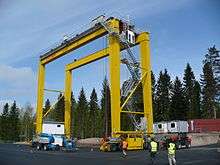Rubber tyred gantry crane
A rubber tyred gantry crane (RTG crane) is a mobile gantry crane used in intermodal operations to ground or stack containers. Inbound containers are stored for future pickup by drayage trucks, and outbound are stored for future loading onto vessels. RTGs typically straddle multiple lanes, with one lane reserved for container transfers. Advantages:its mobility gives a rubber tyred gantry crane wide appliance

Being mobile, RTGs are often powered by diesel generator systems (gensets) of 100 to 600 kW. Due to the lack of an electrical grid to dump energy when containers are being lowered they often have large resistor packs to rapidly dissipate the energy of a lowering or decelerating container.[1] Diesel-powered RTGs are notorious polluters at ports, as each burns up to 10 gallons of diesel fuel per hour.[2]
There are also electric rubber tired gantry cranes.[3] The first electrified rubber-tyred gantry cranes (ERTG) in China was unveiled by the She Kou container terminal (SCT) in Shenzhen in Aug 2008. The new technology reduces fuel consumption by an estimated 95 percent. The new ERTG system was developed with the help of Konecranes, Conductix-Wampfler and Georgia Power.[4] Rubber-tired gantry cranes are also being electrified at the Port of Long Beach to improve air quality, with funding from the California Energy Commission.[2]
Aside from the intermodal industry, RTGs also are extensively used in industry. Applications include erecting large unbalanced structures, assembling large manufacturing components, and positioning pipelines.
References
- Fuel Saving Flywheel Technology for Rubber Tired Gantry Cranes in World Ports
- "US and Global Trade: LA, SSA Marine launch electrification effort to meet emission goals". www.joc.com. Retrieved 2020-05-26.
- "Kalmar Zero Emission RTG | Kalmarglobal". www.kalmarglobal.com. Retrieved 2020-05-26.
- "GPA introduces North America's first ERTG, December 17, 2012". Port Technology. Retrieved 2013-04-15.
